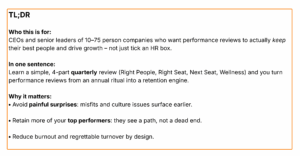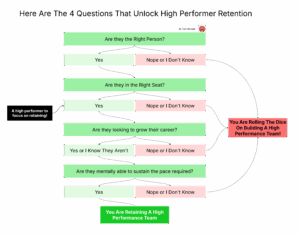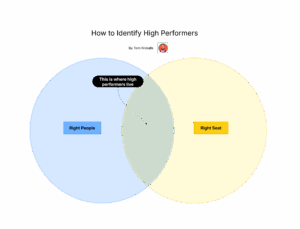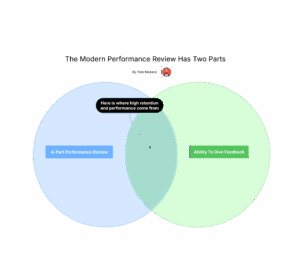
Most CEOs I talk to dread performance review season.
You lose whole weeks to forms and meetings.
Managers rush to remember a year’s worth of work.
A few people get blindsided.
Then, 4 to 6 weeks later, the part that really hurts shows up… you lose some key people.
If that pattern feels familiar, it’s not because feedback is a bad idea.
It’s because the system you’re using is broken.
Traditional reviews are:
- Annual (too rare).
- Backwards-looking (too late).
- Rating-obsessed (too shallow).
They almost never answer the four real retention questions:
- Do we have the right people?
- Are they in the right seat?
- Is there a compelling next seat for the ones we never want to lose?
- Can they sustain this pace without burning out?
The good news: no giant HR overhaul is needed to fix this.
Your managers need a simple, repeatable 4-part conversation that takes a few hours quarterly.
We call it the Modern Performance Review.
We developed our Modern Performance Review with 250+ teams and have seen regrettable turnover decrease ~72%.
For example: right now you lose your top AE every 18 months, with this system you keep them 3-4 years.
Losing one top performer can cost you $150K–$300K; this is the prevention plan.

The 4-Part Review Model: From HR Ritual to Retention Engine
Most reviews grade history, but ours is the only framework laser-focused on the four reasons top performers quit.
We’ve now rolled this out with over 250 companies and across them, we consistently see ~72% fewer regrettable exits and clearer calls on who to keep, coach, or exit.
Rather than you spending time dealing with performance drama, we coach your managers to spend one hour a quarter reviewing each member of their team.
They will spend that time answering 4 questions:
- Right People: Do they live your values in the way they show up every day?
One toxic ‘high performer’ quietly costs you 2 to 3 A-players a year.
- Right Seat: Are they achieving or exceeding expected outcomes?
If you’re paying $150k for a $90k job, that’s a $60k leak; if you pay $90k for a $150k job, you burn opportunity.
- Next Seat: For your high performers, how do they want to create even more value?
- Wellness: Can they actually sustain this, as a human, over the long haul?
If you run this conversation once a quarter, you get three extra chances a year to keep the right people in the right seats, for longer.
Let’s break each part down.
Part 1: Right People
EOS is blunt on this: a Right Person is someone who genuinely lives your core values.
Jim Collins puts it even more sharply:
“People are not your most important asset. The right people are.”
So your review starts here:
“If this person left tomorrow and reapplied, would we enthusiastically rehire them?”
To answer that, you need to get specific about behaviour, not vibes.
Give managers a simple values lens:

You can borrow the EOS People Analyzer idea without turning the whole meeting into a scoring session: look at each value and ask “usually, sometimes, rarely?”
Keeping one toxic ‘high performer’ can cost you multiple high performers in a year.
If that person causes 2 high performers to leave, that’s $300k to $600k in replacement costs (hiring downtime plus months of ramping up replacements).
This part of the review is where you decide whether to protect the culture or the short-term numbers.
Top leaders bet on keeping the people who strengthen their culture, and stop carrying people who tax it.
This week, list your top 5 ‘producers’ and circle any you wouldn’t re-hire because they are not the Right People.
That’s an immediate ROI.
If you don’t have clear values to define the Right People, that is a good place to start.
If you need help, we can create winning values in 2 weeks with you.
Part 2: Right Seat
Once you’re confident they’re the Right Person, the next question is:
“Are they in the Right Seat for them and our business?”
If 30% of your team is not in the Right Seat, that’s not culture pain…
It could be 7-figures of hidden churn and missed profits.
The Right Seat conversation is where you correct it.
One 60-minute review cycle you can surface the 2 to 3 roles that are quietly taxing your profits.
Right Seat in EOS means they GWC the role: they Get it, Want it, and have the Capacity to do it.

That’s a powerful review tool:
Get it: Do they truly understand the outcomes, stakeholders, and trade-offs of this seat?
Want it: Do they still want this seat, or are they here out of habit?
Capacity: At our current speed and complexity, do they actually have the skills and bandwidth?
Managers should ask themselves:

Often, underperformance and simmering frustration are really seat problems, not person problems.
When done right, we see fewer “I was never set up to win” exits and better performance from the people you already have.
Top leaders know the easiest way to grow is to get more from your current team, validating the right seats does this.
Part 3: Next Seat – Keeping Growth-Minded Top Talent
If your top talent does not know where they are going internally, they will look externally!
We came into a client after a $4M producer left over $20k in comp and zero growth path.
That’s the gap this section exists to close.
Here’s the nuance, not all top talent wants a bigger seat.
Some people want to master their current role and stay there.
If they’re the Right People in the Right Seat, that’s gold and you will see it on your bottom line.
Don’t ruin that by forcing them up a ladder they don’t want to climb.
But for those that do want to climb…
The Next Seat conversation is for those:
- High performers who consistently are the Right People in the Right Seat.
- High performers want to grow their impact, scope, or responsibility.
This is where Good to Great earns its keep.
Collins shows that great companies win by getting the right people on the bus, keeping them there, and then moving them into the seats where they can create the biggest long-term impact.
Internal promotions and thoughtful seat changes consistantly out perform external hires.
To be clear, you’re not promising a promotion in three months.
You’re agreeing on a 12 to 24 month path and agreeing to help them prepare for that new seat.
In the review, your managers are asking growth-minded top performers:

If they light up talking about leading people, new markets, or a specialist track, that’s your signal.
You don’t have to promise a promotion tomorrow, but you do need to sketch what a credible next seat might look like and what would need to be true to get there.
If one high performer turns into a great manager and stays 3 years longer, that’s 3 full cohorts of hires they onboard instead of you.
That is the kind of force multiplier that bends your growth curve, revenue and profits way up!
Part 4: Wellness – Sustain Without Burning Out
Performance reviews that ignore wellness are booby-trapped.
When a $180k engineer burns out and quits, you lose 6 to 9 months of productivity plus ~$100k in replacement and ramp up costs.
Making the 10-minute wellness conversation is the cheapest insurance you’ll buy.
Gallup’s research on burnout is clear: it’s less about hours and more about unfair workload, lack of control, and insufficient support.
Burned-out employees are far more likely to be actively looking for another job.
High performers are often the worst offenders.
They wear “I never take a vacation” as a badge of honour… right up until they disappear.
So this part of the review is intentionally human-to-human.
Before the meeting, have managers pull a simple report from your HRIS:
- Did this person take any real time off this quarter?
- Do they have anything booked for next quarter?
If the answer is “no” and “no,” that’s a red flag, not a sign of commitment.
In the conversation, you’re asking:

And if they haven’t taken time off, you actually encourage them to book some and explain why: burnout hurts them, their manager, and the company.
So today, open your HRIS and find at the top 10 people with the fewest days off.
That’s your burnout-risk list to focus on!
Two Quick Examples: What This Looks Like in Real Life
Example 1 – Keeping a star engineer
A 35-person SaaS company has a senior engineer whom everyone relies on.
In the 4-part review:
- Right People / Right Seat: Green across the board.
- Next Seat: He admits he’s been taking recruiter calls because there’s no clear growth path.
- Wellness: He hasn’t taken a real break in a year.
They design a Senior Lead Engineer “next seat,” to give him a cross-team architecture project, and plan a proper vacation.
Eighteen months later, he’s still there, leading critical work that would have been painful to backfill.
Replacing a senior engineer would take 3+ months and 6 months to fully ramp up, which would cost the company $100k+.
Example 2 – Holding onto a high-billing consultant
In a 25-person services firm, a top consultant is hitting numbers but quietly fraying. The review surfaces:
- Right People: Clients love her; she lifts the team.
- Right Seat: Her current portfolio is unsustainable.
- Next Seat: She wants to build a new service line, not just deliver.
- Wellness: She hasn’t booked time off in 6 months.
They rebalance her book of business, carve out time to incubate the new offer, and lock in two weeks’ vacation.
You can see how this model moves you from “hope they don’t quit” to “we’re actively designing a future with them.”
Losing a key person like this would cost the business $350k+ in hiring time, onboarding and lost clients.
Why We Run Them Quarterly?
If you only talk about performance once a year, your maximum correction speed is 12 months.
Our Modern Performance Review drops it to 90 days.
This alone gives you three extra chances before someone hits a wall or starts interviewing.
That’s a 4x faster feedback loop on your most expensive line item: payroll.
Mechanism + Skill = Success
Our 4-part Modern Performance Review gives you the mechanism and cadence.
If each part prevents just one regrettable exit per year, that’s 4x $150k–$300k you avoid paying.
If Castle HR only worked on this for a year, your ROI would be 833% to 1,567%!
We call that an HROI 🙂
If you want retention and performance to scale with headcount, you need a system any competent manager can run.
The Modern Performance Review is that system.
But the quality of the conversation still depends on whether managers know how to:
- Give clear, specific feedback (not “you’re doing great”).
- Have hard conversations early.
- Coach someone up or out using your company’s style.

Many of our clients use Radical Candour to show a caring personally while challenging directly.
It’s the antidote to “ruinous empathy,” where managers avoid hard feedback until it’s too late.
One technique we teach is FBI feedback:

At Castle HR, we also coach your managers on those skills separately.
But this article isn’t about coaching, that is for another day!
The point here is: don’t confuse the form with the skill.
You need both.
Why This 4-Part Review Lifts Retention
When you look at the model through a retention lens, it’s simple:
- Right People → you stop losing good people because of bad ones.
- Right Seat → you stop bleeding talent who were never set up to win.
- Next Seat → your best people see a future with you, not just elsewhere.
- Wellness → you stop being surprised by burnout exits.
Research backs this up: organizations that invest in ongoing performance and development see higher productivity and significantly lower turnover.
You’re not doing reviews because “HR says so.”
You’re doing them because it’s cheaper to keep your best people than to replace them, and this is one of the most reliable levers you have.
Your Move This Quarter
Before you roll out anything new, start by holding a mirror up to what you already do.
Look at your current performance review process and ask yourself:
- “Does this actually help me keep my best people, or just tick a box?”
- “Where in our process do we truly talk about Right People, Right Seat, Next Seat, and Wellness?”
- “If I asked my A-players whether reviews make them want to stay longer, what would they say?”
If you can’t answer ‘yes’ to at least 3 of those questions, you don’t have a retention system; you have paperwork.
You do not have to blow everything up tomorrow.
Start by spotting the gaps.
Maybe your forms are acceptable, but there is no real Next Seat conversation.
Maybe managers never look at time off before a review.
Maybe values only show up as checkboxes, not as an honest discussion about behaviour.
If you want a sounding board, we are here.
This 4-part model is used by over 250 companies every quarter.
If you want to steal our playbook, we’ll walk you through exactly how we’d use this to buy back 1 to 2 years of tenure from your top performers.
Schedule a call with Tom, and he can walk you through the framework, the questions, and how other CEOs are using it to boost retention and maintain high performance.
No pressure, just a practical conversation about what is working and what is not in your world.

Tom Nickalls is the founder and CEO of Castle HR. Castle was launched in 2019 with the mission of helping businesses build high-performance teams by prioritizing culture, onboarding, and employee development. Since then, Castle has grown exponentially and empowered 100+ companies in Canada to scale smarter with modern, fractional HR service and strategy. Passionate about fostering strong workplace dynamics, Tom is dedicated to aligning business success with employee satisfaction in the ever-evolving world of work.